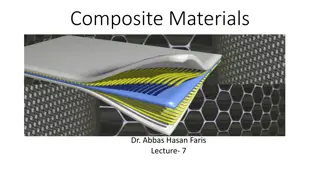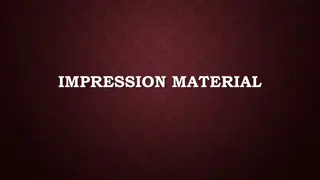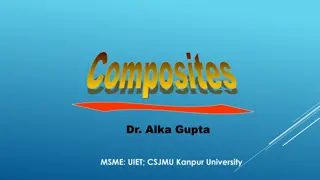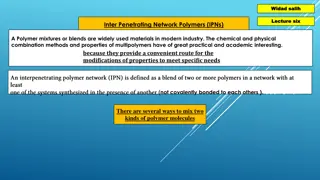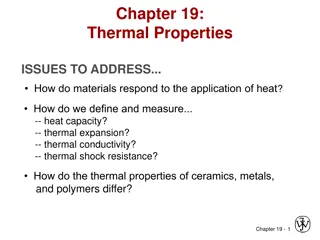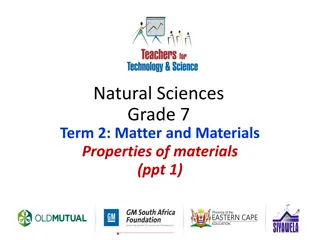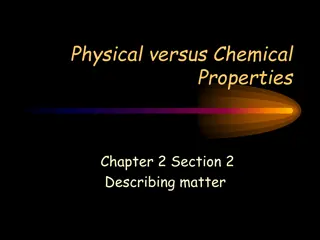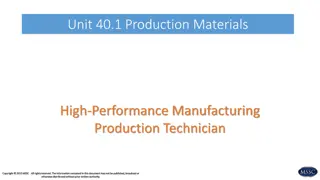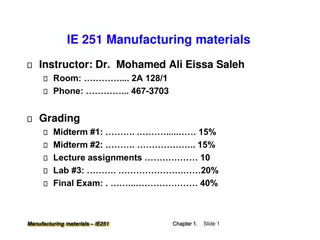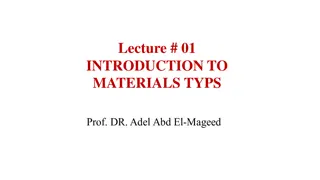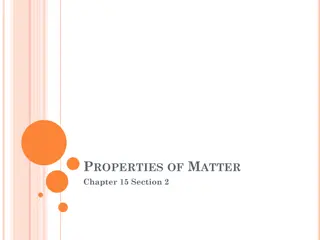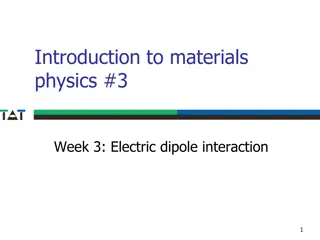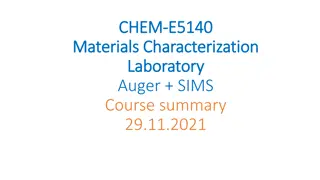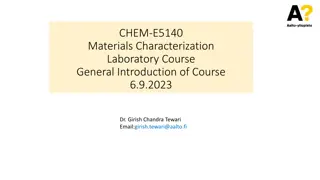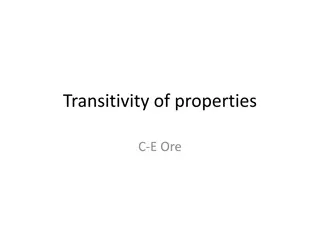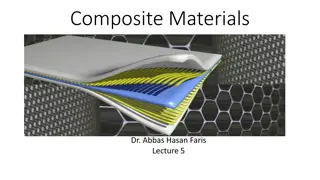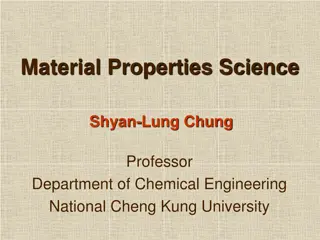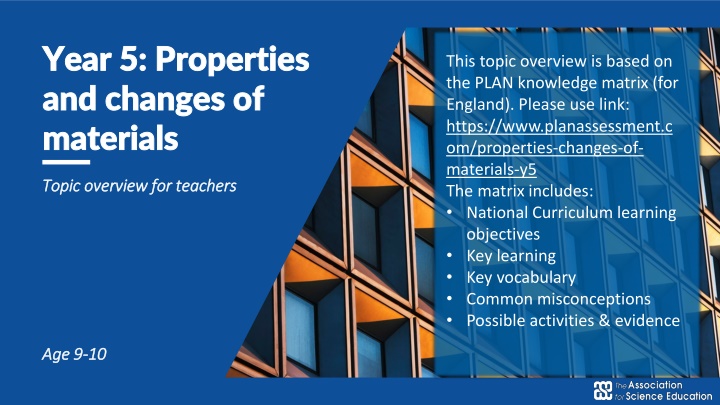
Exploring Properties and Changes of Materials in Year 5
Discover the key learning points for Year 5 students on the properties and changes of materials. Explore topics such as thermal insulation, reversible and irreversible changes, and the uses of different materials. Engage in hands-on activities to deepen understanding. Utilize resources and activities outlined in the PLAN knowledge matrix for England.
Download Presentation

Please find below an Image/Link to download the presentation.
The content on the website is provided AS IS for your information and personal use only. It may not be sold, licensed, or shared on other websites without obtaining consent from the author. If you encounter any issues during the download, it is possible that the publisher has removed the file from their server.
You are allowed to download the files provided on this website for personal or commercial use, subject to the condition that they are used lawfully. All files are the property of their respective owners.
The content on the website is provided AS IS for your information and personal use only. It may not be sold, licensed, or shared on other websites without obtaining consent from the author.
E N D
Presentation Transcript
Year 5: Properties Year 5: Properties and changes of and changes of materials materials This topic overview is based on the PLAN knowledge matrix (for England). Please use link: https://www.planassessment.c om/properties-changes-of- materials-y5 The matrix includes: National Curriculum learning objectives Key learning Key vocabulary Common misconceptions Possible activities & evidence Topic overview for teachers Topic overview for teachers Age 9 Age 9- -10 10
Year 5 Properties and changes of materials Topic Key Learning Materials have different uses depending on their properties. Properties include hardness, flexibility, absorbency, strength, transparency, electrical and thermal conductivity and attraction to magnets. page Exploring properties and uses of materials 4 Investigating thermal insulators Thermal insulators do not allow heat to pass through them easily. Materials which trap air inside them are good thermal insulators. 5 Comparing soluble and insoluble materials Some materials will dissolve in a liquid and form a solution. They are soluble materials. Other materials do not dissolve in a liquid. They form a sediment. These materials are insoluble. 6 2
Year 5 Properties and changes of materials Topic Key Learning Some changes to materials such as dissolving and mixing are reversible. The materials can be separated, as no new materials have been formed. Insoluble materials can be separated from a liquid by sieving or filtering. Soluble materials can be separated from a liquid by the process of evaporation. page Investigating reversible changes by separating materials 7 Understanding that changes of state are reversible (see Year 4 topic for a more detailed set of lessons) Melting is a change of state from solid to liquid. Freezing is a change of state from liquid to solid. Boiling and evaporating are both a change of state from liquid to gas. Condensing is a change of state from gas to liquid. All changes of state are reversible. 8 Exploring irreversible changes Some changes to materials are not reversible. New materials are formed. These are called irreversible changes. Burning wood, rusting, cooking food and mixing vinegar with bicarbonate of soda are examples of irreversible changes. 9 3
Properties and changes of materials Properties and changes of materials Exploring properties and uses of materials Exploring properties and uses of materials Key Learning Materials have different uses depending on their properties. Properties include hardness, flexibility, absorbency, strength, transparency, electrical and thermal conductivity and attraction to magnets. Activities and websites Exploring prior knowledge about properties of materials. https://www.bbc.co.uk/bitesize/topics/z4339j6/ articles/zx8hhv4 Using Carroll diagrams to classify household items/materials by their properties. Optional activity to investigate an object made of two or more materials, such as a bike or skateboard. I can use Carroll diagrams to classify materials by their properties. https://www.dkfindout.com/uk/science/materi als/ 4
Properties and changes of materials Properties and changes of materials Investigating Investigating thermal insulators thermal insulators Key Learning Thermal insulators do not allow heat to pass through them easily. Materials which trap air inside them are good thermal insulators. Activities and websites Exploring ideas about how you might stop a snowman from melting. Investigating how quickly an ice cube melts with or without a jacket on. This is a comparative test. Plotting a bar chart or a line graph. Optional activity to try a further investigation: How else could you investigate the time it takes for a snowman to melt? I can investigate how to stop a snowman melting using a comparative test. plot a bar chart or a line graph with my results. 5
Properties and changes of materials Properties and changes of materials Comparing soluble and insoluble materials Comparing soluble and insoluble materials Activities and websites Exploring what happens when you add sugar to a warm drink. Key Learning Some materials will dissolve in a liquid and form a solution. They are soluble materials. Other materials do not dissolve in a liquid. They form a sediment. These materials are insoluble. https://www.bbc.co.uk/bitesize/topics/zcvv4wx/articl es/zpbdpbk Comparing soluble and insoluble materials we use in the kitchen. Optional activities to find out more about the properties of salty water. https://pstt.org.uk/application/files/6115/8633/7142/3._EGG- CITING_SCIENCE.pdf I can identify and compare soluble and insoluble materials. https://www.dkfindout.com/uk/earth/oceans-and-seas/ https://www.wildlifetrusts.org/why-sea-salty-and-why-sea-blue https://www.nhm.ac.uk/discover/quick-questions/why-is-the-sea- salty.html 6
Properties and changes of materials Properties and changes of materials Investigating reversible changes by Investigating reversible changes by separating materials separating materials Activities and websites Exploring how sieves and colanders are used in the kitchen. Considering how you can separate materials that are mixed together. Key Learning Some changes to materials such as dissolving and mixing are reversible. The materials can be separated, as no new materials have been formed. Insoluble materials can be separated from a liquid by sieving or filtering. Soluble materials can be separated from a liquid by the process of evaporation. https://www.bbc.co.uk/bitesize/clips/z9jd7ty https://www.bbc.co.uk/bitesize/topics/zcvv4wx/articles/zw7tv9q Separating materials using sieving, filtering and evaporating. Optional further activities to explore separating mixtures. I can select equipment to separate two or more materials using sieving, filtering and/or evaporating. https://www.youtube.com/watch?v=sgRnDK4CFX4 https://pstt.org.uk/resources/curriculum-materials/Science-Fun-at- Home 7
Properties and changes of materials Properties and changes of materials Understanding that changes of state are reversible Understanding that changes of state are reversible Activities and websites Exploring prior knowledge about melting, freezing, boiling, evaporating and condensing. Key Learning Melting is a change of state from solid to liquid. Freezing is a change of state from liquid to solid. Boiling and evaporating are both a change of state from liquid to gas. Condensing is a change of state from gas to liquid. All changes of state are reversible. https://www.bbc.co.uk/bitesize/topics/zkgg87h/articles/z9ck9qt https://www.bbc.co.uk/bitesize/topics/zkgg87h/articles/zydxmnb Observing and describing changes of state including melting, freezing, evaporating and condensing. Optional activities to find out more about how chocolate is made or to try making chocolate ice cream. I can https://www.youtube.com/watch?v=OnE_84GtPdU&list=PLg7f- TkW11iV563gfcXjRlafm2jlklQOc&index=12&t=0s observe and describe changes of state, including melting, freezing, evaporating and condensing. https://www.youtube.com/watch?v=-JcNMN0uvvE 8
Properties and changes of materials Properties and changes of materials Exploring irreversible changes Exploring irreversible changes Key Learning Some changes to materials are not reversible. New materials are formed. These are called irreversible changes. Burning wood, rusting, cooking food and mixing vinegar with bicarbonate of soda are examples of irreversible changes. Activities and websites Exploring different types of change which can be made to materials. https://www.bbc.co.uk/bitesize/clips/zc84d2p Identifying and comparing reversible and irreversible changes. https://www.bbc.co.uk/bitesize/topics/zcvv4wx/articl es/z9brcwx https://www.bbc.co.uk/bitesize/clips/zc89wmn I can compare reversible and irreversible changes. recognise that new materials are formed during an irreversible change. https://www.bbc.co.uk/bitesize/clips/z9wkjxs Optional further activities to explore irreversible changes. (See website links on page 7 of this lesson.) 9

